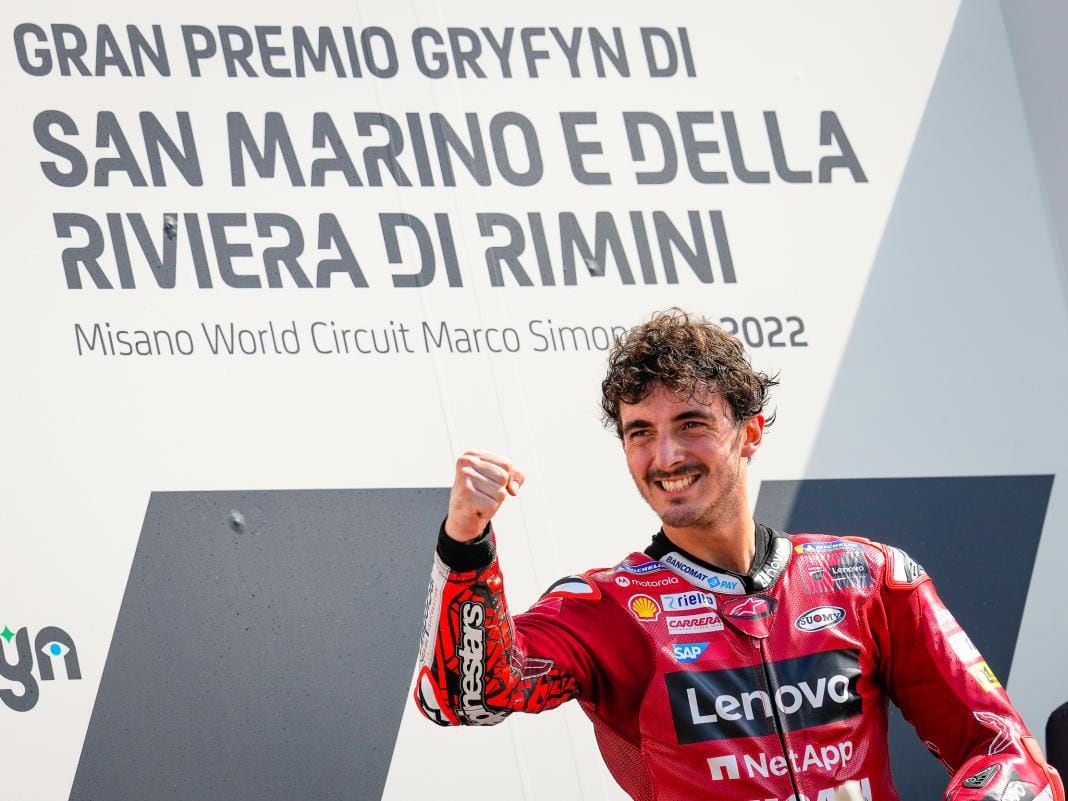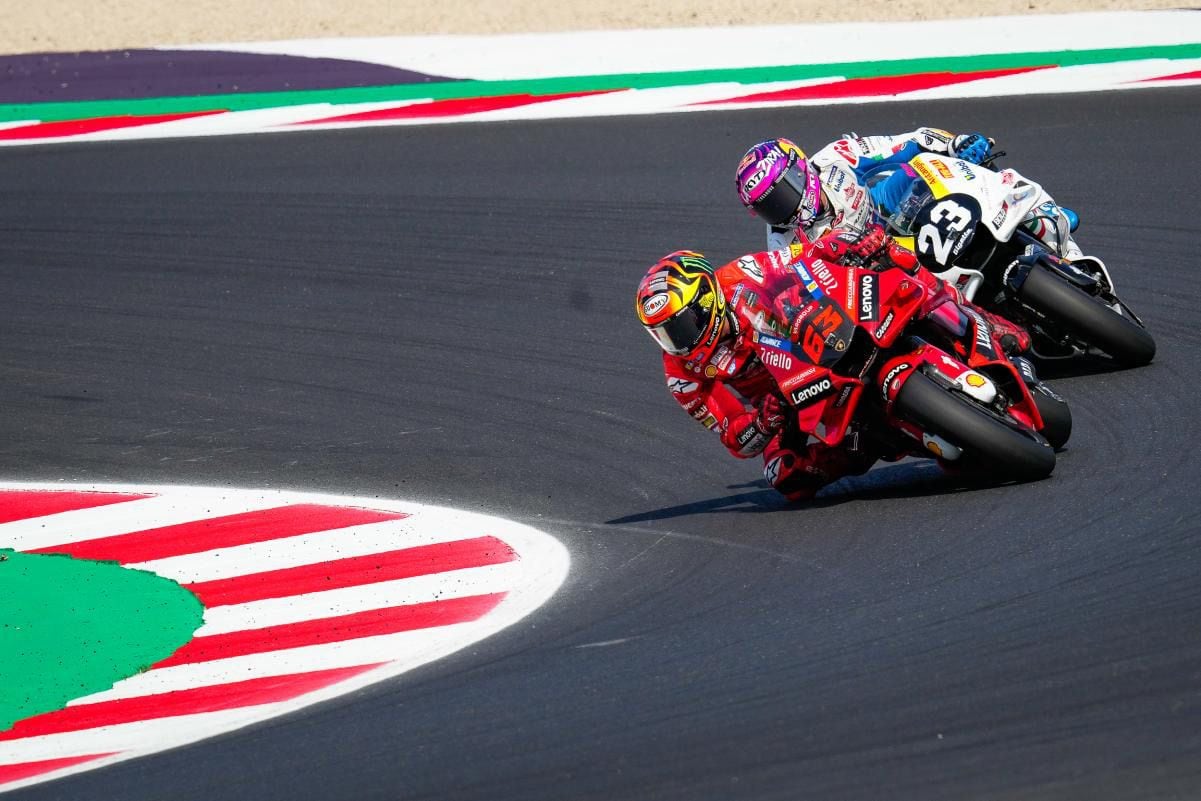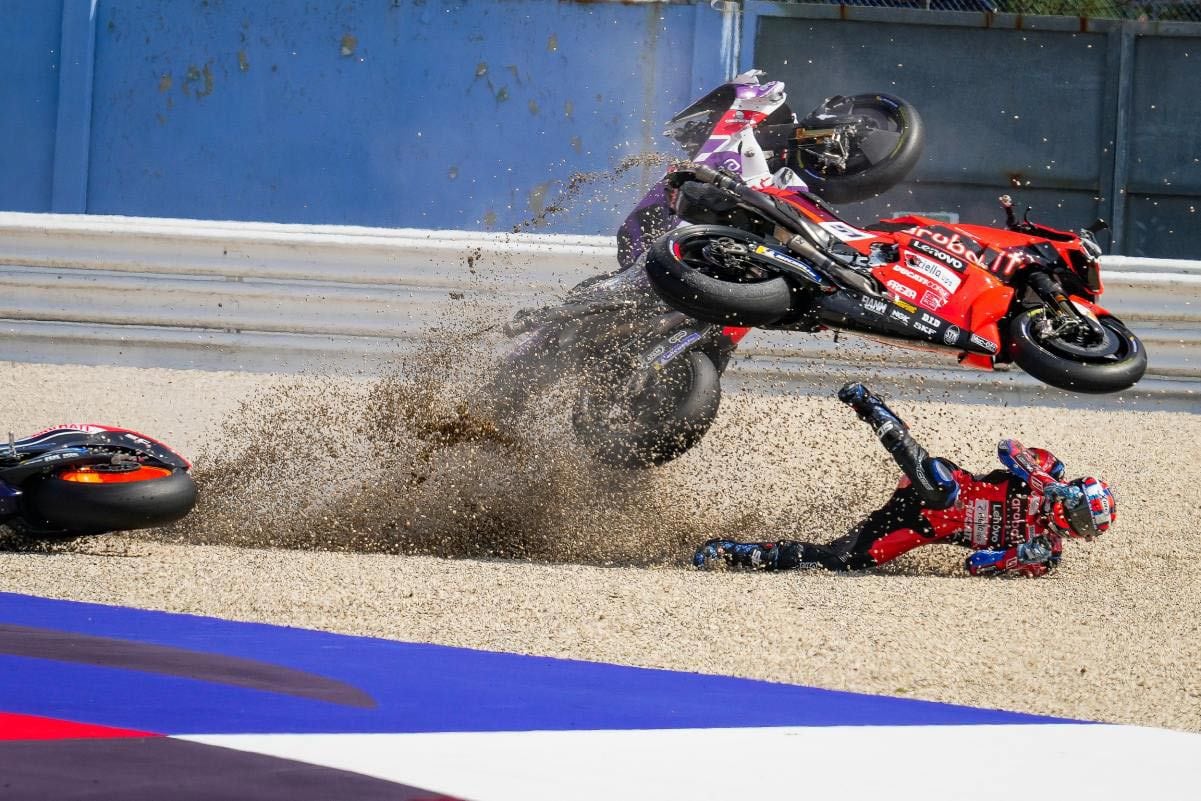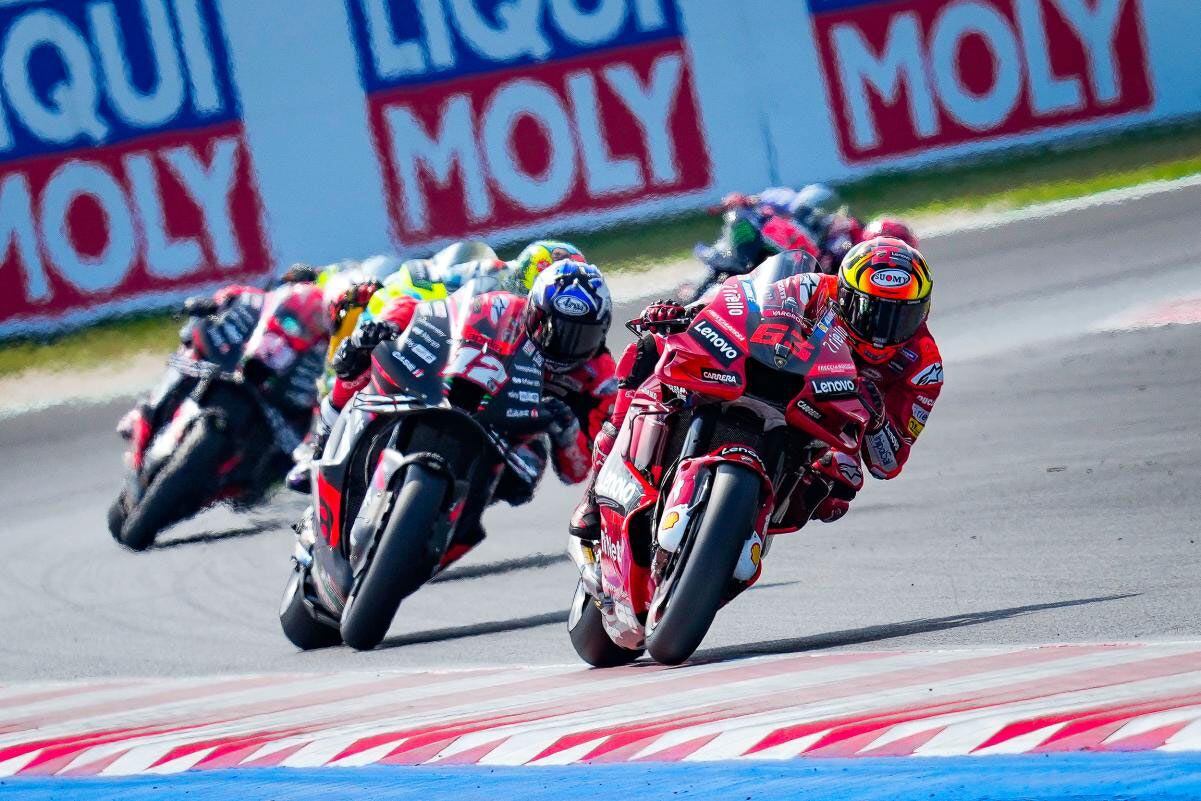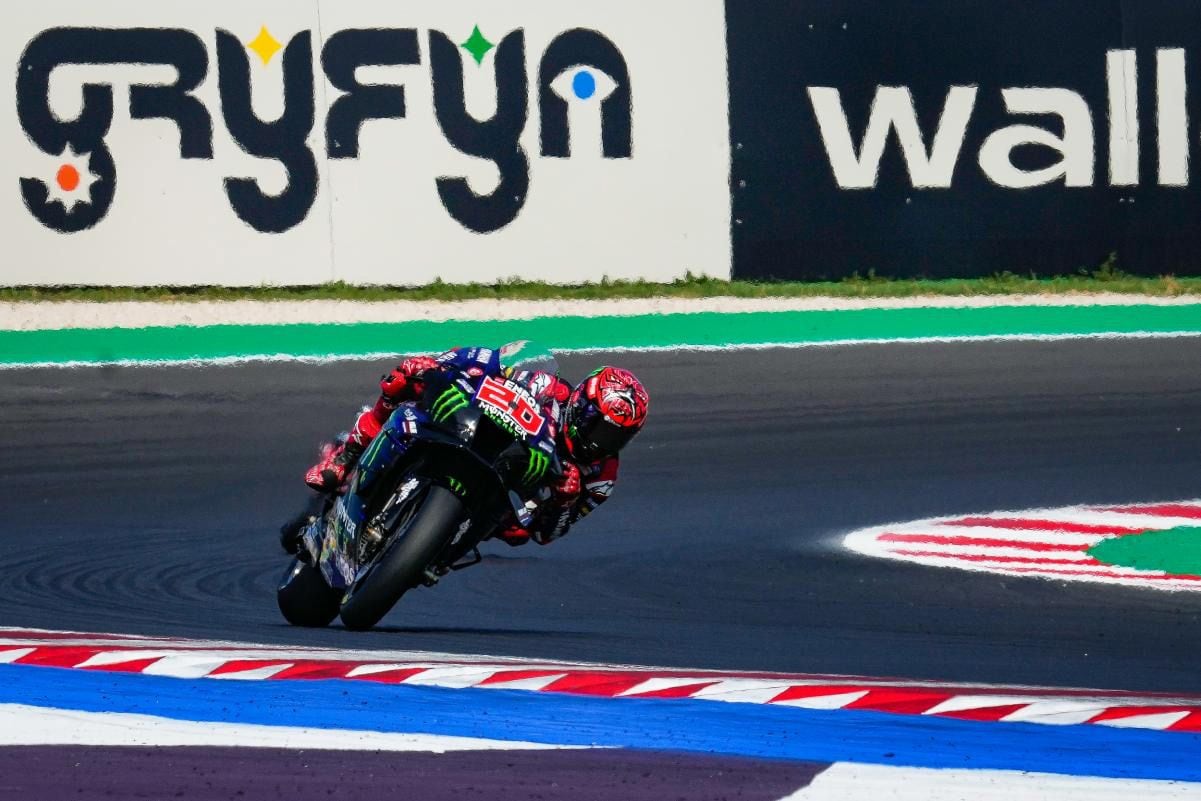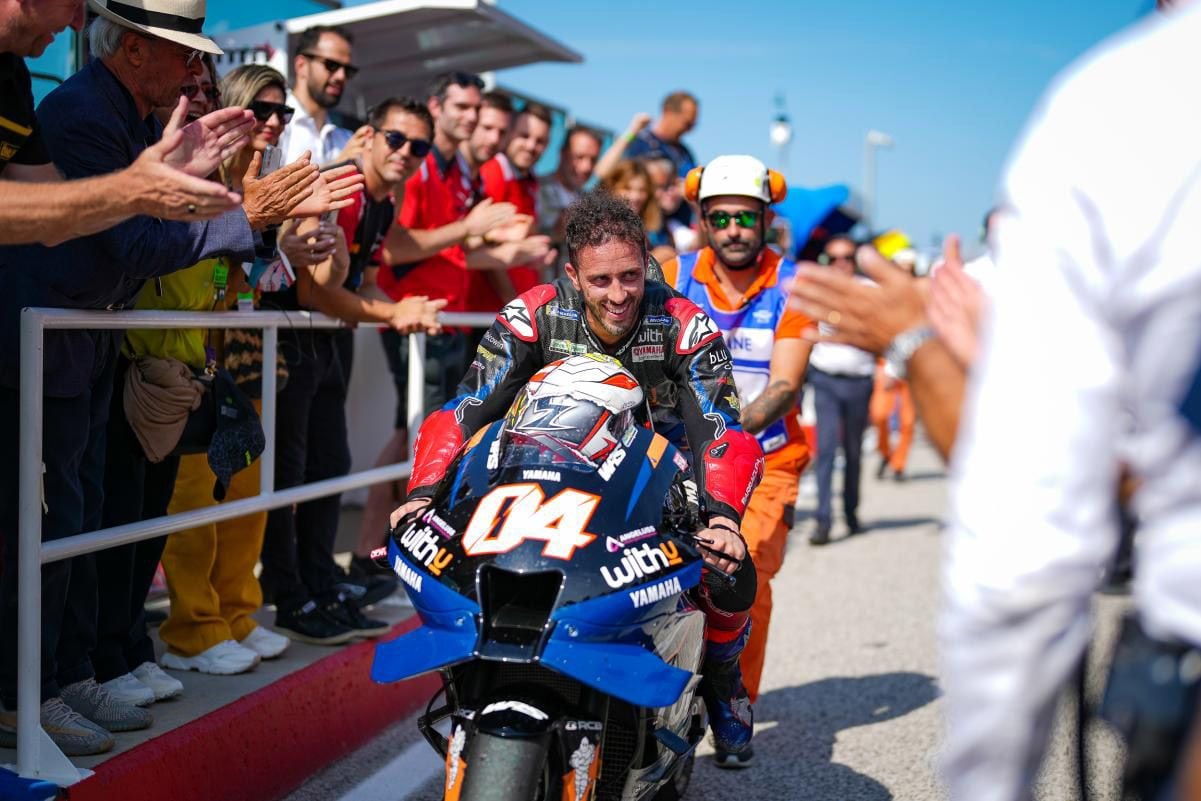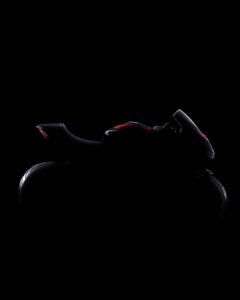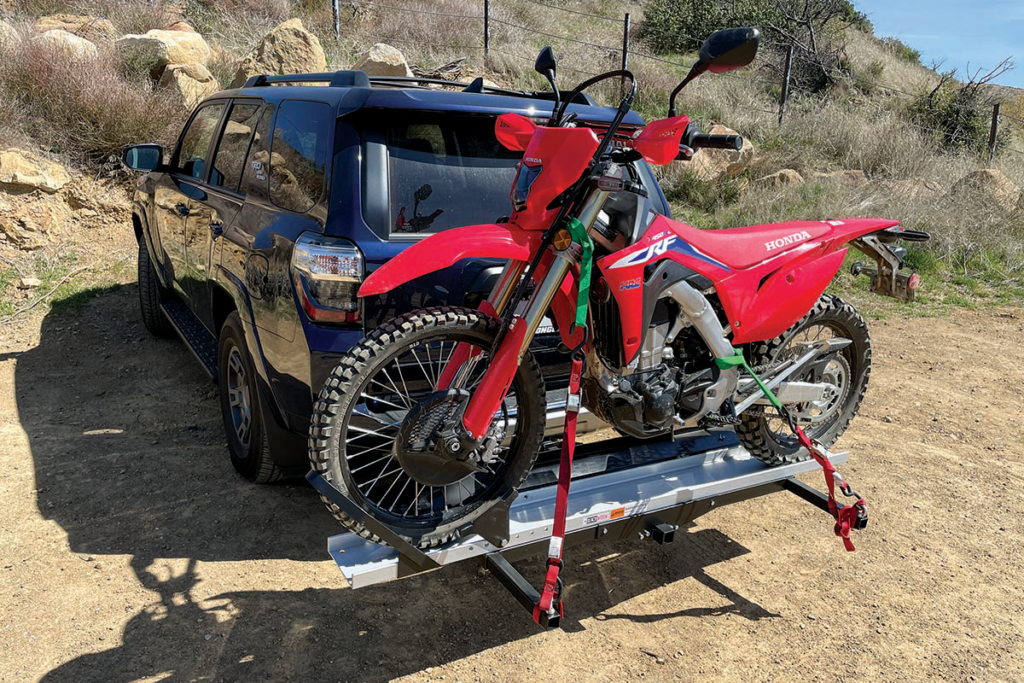Francesco Bagnaia, triumphant, led from the third lap to win and moved into second place in the points. (MotoGP/)Ducati’s big team strategy of fielding eight bikes—more than any other manufacturer—has at last born fruit. Francesco “Pecco” Bagnaia and Enea Bastianini—both on Ducatis—fought out a frenetic last lap to a 0.034-second victory for “Pecco.” Between Bagnaia and the Yamaha-mounted championship leader Fabio Quartararo (who finished fifth) were two Ducatis and the Aprilia of Maverick Viñales (third), acting as “spacers” to reduce Quartararo’s points haul to 11. This elevated Bagnaia to second overall, advancing past Aleix Espargaró (Aprilia) resulting in the following standings after Misano:
Quartararo 211 points
Bagnaia 181 points
Espargaró (Aleix) 178 points
Bastianini 138 points
Zarco 125 points
A near-collision between Bastianini and leader Bagnaia on the last lap was resolved by the latter’s braking so sharply as to raise the rear wheel. This resulted in a post-event “release of tension” from Ducati CEO Claudio Domenicali:
“When two pilots don’t work well together I’m half happy. We have talked to all our riders. They know that they must not be too aggressive amongst themselves. Enea did well, but on the last lap…he risked too much. We do not like it. I know it is part of the nature of riders but there are 150 people working behind them. There is a company. You have to try to work for the team.”
Close late-race competition between Bagnaia and Enea Bastianini enchanted those in the crowd, if not those at Ducati. (MotoGP/)Bastianini said in the post-race press conference that “he knew what he was doing,” and you would expect that the yearslong process of arriving in MotoGP would keep every one of these professional young men aware that “accidentally” taking down the two lead Ducatis would mean never having lunch in Bologna again. Even so, there is speculation as to how these two forceful racers will be organized to a common purpose in future.
Both qualifying and Sunday-morning warmup foreshadowed the race. In Qualifying Quartararo was eighth, with six Ducatis and Viñales’ Aprilia ahead of him (and Jack Miller on pole); in warmup the order was (with their race results in brackets):
Bastianini [second]
Bagnaia [first]
Marini [fourth]
Quartararo [fifth]
Viñales [third]
Ducati’s Mature Setup
Early in the season it appeared that Ducati riders on year-old machines had an initial advantage over those on ‘22 models—a mature setup. It now appears that Ducati has worked out effective setups for those on the new bikes as well.
Cold tires sent Michele Pirro, Espargaró, Johann Zarco off early. (MotoGP/)A bit of rain fell as qualifying began. The old pavement on pit lane was wet, so riders went out on wet tires…only to discover that the repaved track looked dry. In they came for slicks, losing some time. And Quartararo, committed by his own style and that of the M1 Yamaha to riding the big line at high corner speed, noted that the wet denied him the use of the curbing.
Aleix Espargaró noted, “I touched a white line in the first lap and almost [went flying].”
Quartararo said, “Eighth was the maximum I could do in those conditions, so I’m disappointed. In the race I will have to make a great start [from eighth?], do a good first lap, and then play a lot in the first four corners, because that’s where I think I can overtake.”
After the usual discussion of tire choice, everyone except first-timer Kazuki Watanabe (Suzuki) chose hard front, medium rear. Bagnaia was assessed a three-position start penalty for being slow on the racing line.
Quartararo had no magic bullet: On lap one he lost a position while three riders—Johann Zarco (Ducati), Pol Espargaró (Honda), and Ducati test rider Michele Pirro—crashed out. Those hard fronts were slow to reach service temperature. Miller led the first lap, then crashed and remounted. Bastianini led the second, and then Bagnaia took over to lead the third and all subsequent laps—by narrow margins—to win.
Bagnaia said it this way: “At the beginning of the race I had no grip, neither front nor rear. I got to turn 4 and the front locked up. The next lap Miller crashed and I saw Enea (ahead of him at the time) lose the front at turn 14. In the next lap it happened to me at the Curvone. I was scared. I wasn’t able to be fast.”
Cold-tire paralysis. But the mind keeps on working, and by lap three Bagnaia was leading.
Quartararo said bleakly, “There was no problem, that’s the thing.”
In other words, no tire drop, no bouncy overheated front or mystery grip loss at the rear. No cause other than the obvious—his Yamaha couldn’t go any quicker.
“If you check the pace,” he continued, “I had the same pace as practice. I felt quite good on the bike.
“No, I will not say I’m worried [about his dwindling lead in the championship], but I’m also not calm.”
Maverick Viñales showed impressive form, persisted in second for a good stretch, and displayed good judgment in settling for third. (MotoGP/)He was able to pass Aleix Espargaró. “I passed Aleix, but [it was] because he made a mistake and maybe he wasn’t quite right in terms of grip. I couldn’t do anything more.”
Earlier he had said of Misano, “It’s a track where there’s a lot of acceleration and braking.” Those remain Ducati’s greatest strengths.
Viñales Reappears
A big surprise this year is that Viñales, after seasons of whining that nothing was going his way, has come to terms with the Aprilia and has become the real force that his strong second season—2016—predicted for him.
Viñales was second behind Bagnaia for 17 laps at Misano, always by a fraction of a second.
He said, “I always had in my mind the race from 2020 when I put a lot of pressure on Pecco and he made a mistake. Today I was trying it but he [has] improved. He didn’t make even one slight mistake. When Enea passed me (lap 20) I started to struggle a little bit. Then I just said, ‘Today it’s third, Maverick.’”
Luca Marini (fourth) had something incisive to say: “…we are looking for the solution to be competitive right away on race weekends. I think it’s important to start with an ideal setup and show your potential right from FP1.”
Point leader Fabio Quartarao came fifth, but has a 30-point cushion going into Aragon. (MotoGP/)That will be even more true next year when the new Sprint Race takes the place of FP4, and qualifying fixes your start position in both races. Every lap on the track, on every day, will be a potential determining factor. The sooner the bike is right, the more likely it is that the rider can qualify forward enough to get away with the lead group, with the pace to be “in amongst ‘em.”
Marini estimated, “To beat Viñales maybe just one-tenth [of a second per lap], two instead to stay together with Bagnaia and Bastianini.”
The “D” Word: Data
Another advantage of Ducati’s having so many bikes entered is gathering data faster. Ducati are now in the enviable position of having built a bike that can be ridden at winning pace by multiple riders. By contrast, Honda’s whole success in recent years is owed to the unique abilities of Marc Márquez; no other Honda rider has come consistently close. It’s the same with Quartararo and the Yamaha—nothing would have changed had he been the only rider on that bike. He alone has put the Yamaha up front.
Bastianini said of his last-lap rush, “I got very close to him in the last two corners. In the last corner I was undecided but I preferred not to risk it—I would have fallen. So I bet on acceleration. We were close.”
Of Bastianini in those last seconds, Bagnaia said, “…he was able to put more power on the ground and accelerate more.”
Bagnaia’s counter strategy: “In the last lap I just tried to have more corner speed [which makes braking and acceleration to a degree less necessary]. I was feeling that I was without a rear tire and rear traction. So I used all the corner speed and just went wide on the corner exit.”
Increased apex-speed capability is recent for Ducati—reducing the traditional Yamaha/Quartararo advantage in that area.
Misano was the last go-round for Andrea Dovizioso, the man who worked out how to make today’s Ducatis work out. (MotoGP/)Ciao, Dovi
This was the last MotoGP for retiring Andrea Dovizioso, the man who first worked out a method of being fast while making the tires last on the Ducati. For years he pointed to its weakness: lack of side grip for speed in midcorner. Ducati continued to gamble that being fast in (hard braking) and fast out (super acceleration) could do the whole job. Dovi and all the evidence (the years of Ducatis finishing sixth and seventh) denied it. Bagnaia honored him: “I want to take the opportunity to thank Dovi because if our bike is like this today [being hailed as the most well-rounded in the paddock], it is…thanks to what he did.”
Aragon is next, then the flyaway events.


